
Woonsocket, is a city in Providence County, Rhode Island, United States. The population was 41,186 at the 2010 census, making it the sixth largest city in the state. Woonsocket lies directly south of the Massachusetts state line and constitutes part of both the Providence metropolitan area and the larger Greater Boston Combined Statistical Area.

The Blackstone River is a river in the U.S. states of Massachusetts and Rhode Island. It flows approximately 48 mi (80 km) and drains a watershed of approximately 540 sq. mi (1,400 km2). Its long history of industrial use has left a legacy of pollution, and it was characterized by the United States Environmental Protection Agency in 1990 as "the most polluted river in the country with respect to toxic sediments."

The Blackstone Canal was a waterway linking Worcester, Massachusetts, to Providence, Rhode Island through the Blackstone Valley via a series of locks and canals during the early 19th century.

The Slater Mill is a historic textile mill complex on the banks of the Blackstone River in Pawtucket, Rhode Island, modeled after cotton spinning mills first established in England. It is the first water-powered cotton spinning mill in North America to utilize the Arkwright system of cotton spinning as developed by Richard Arkwright.
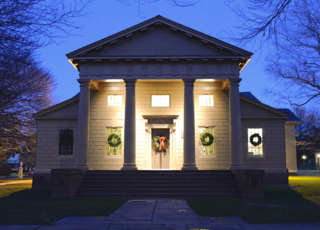
The Redwood Library and Athenaeum is a subscription library located at 50 Bellevue Avenue, Newport, Rhode Island. Founded in 1747, it is the oldest community library still occupying its original building in the United States. The original building was designed by Peter Harrison and completed in 1750, and is a National Historic Landmark.
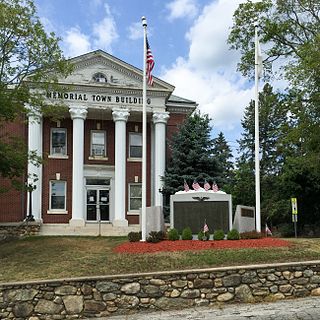
Slatersville is a village on the Branch River in the town of North Smithfield, Rhode Island, United States. It includes the Slatersville Historic District, a historic district listed on the National Register of Historic Places. The historic district has been included as part of the Blackstone River Valley National Historical Park. The North Smithfield Public Library is located in Slatersville.
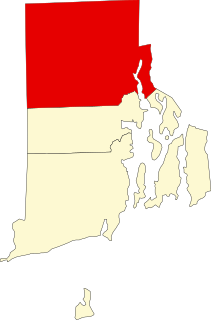
This is a list of the National Register of Historic Places listings in Providence County, Rhode Island.
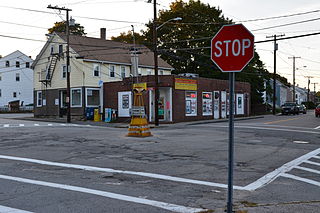
Albion is a village and historic district in Lincoln, Rhode Island, in the United States.

The College Hill Historic District is located on the East Side of Providence, Rhode Island, United States. It was designated a National Historic Landmark District on December 30, 1970. The College Hill local historic district, established in 1960, partially overlaps the national landmark district. Properties within the local historic district are regulated by the city's historic district zoning ordinance, and cannot be altered without approval from the Providence Historic District Commission.

The Newport Steam Factory is an historic building at 449 Thames Street in Newport, Rhode Island. It is a 3-1/2 story stone structure, 120 feet (37 m) by 48 feet (15 m). It was built in 1831 by a group of local businessmen in an effort to boost the local economy, which had suffered since the British occupation during the American Revolutionary War. The building was used as a cotton mill until 1857. In 1892 it was purchased by the Newport Illuminating Company. It is now part of the International Yacht Restoration School.

Allen Street Historic District is a historic district encompassing a collection of smaller textile mills in central Woonsocket, Rhode Island. The district extends on either side of Allen Street, a road isolated between Truman Drive and the Blackstone River, and includes buildings dating from c. 1860 to c. 1930. Of the five textile mill buildings in the district, four are brick structures built between about 1900 and 1920; the oldest building in the district is the c. 1860 Pond's Warp Mill at 148 Bernon Street. The latter is also adjacent to a rare visible fragment of the once-extensive canal works that characterized the industrial center of Woonsocket. Many of the district's buildings have been converted to housing.

Allendale Mill is a historic mill at 494 Woonasquatucket Avenue in North Providence, Rhode Island, on the banks of the Woonasquatucket River.

The Island Place Historic District is a historic district at Island Place and South Main Street at Market Square in Woonsocket, Rhode Island. The district includes six historic buildings, three of which are part of the Woonsocket Rubber Company Mill, dating from c. 1857 to c. 1919. The other buildings in the district are the Island Machine Company, the Barnai Worsted Company Dyeworks, and a wood-frame structure, that is the last surviving elements of the Wilkins Manufacturing Company. The district is bounded by Market Square, Bernon Street, and a bend in the Blackstone River. The site is now home to the Museum of Work & Culture, a project of the Rhode Island Historical Society.

St. Ann's Church Complex is now a historic cultural center in Woonsocket, Rhode Island on Cumberland Street. It was formerly a Roman Catholic church within the Diocese of Providence.

The Candace Allen House is a historic house located at 12 Benevolent Street in the College Hill neighborhood of Providence, Rhode Island. Named after Candace Allen (1785-1872) m older sister of Zachariah Allen, a prominent Providence mill-owner.
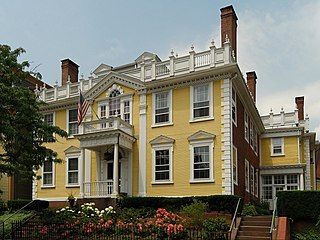
The Edward Dexter House is an historic house at 72 Waterman Street in the College Hill neighborhood of Providence, Rhode Island. It is a 2-1/2 story wood frame structure, built in 1795–1797, with a hip roof topped by a square monitor. Its main facade is five bays wide, with the center bay flanked by two-story pilasters and topped by a small gable pediment. The well-preserved interior provided a template for an early-20th-century museum space designed by the Rhode Island School of Design to house a furniture collection donated by the house's then-owner, Charles Pendleton. The house is one of the few 18th-century houses in the city's College Hill neighborhood. It was originally located at the corner of George and Prospect Streets; in 1860 it was sawn in half and moved in sections to its present location.
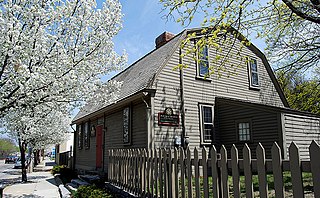
The Jeremiah Dexter House is an historic colonial house at 957 North Main Street in Providence, Rhode Island. It is a 1-1/2 story gambrel-roofed wood frame structure, built in 1754 for printer Jeremiah Dexter on farm land that was originally granted to his ancestor Gregory Dexter, a friend and printer for Roger Williams. It is five bays wide, with a large central chimney typical of the period, and is one of the few surviving colonial-era farmhouses in the city. The Dexter farm is further notable as the site where French Army troops were stationed upon their return from Virginia in 1782, during the American Revolutionary War. The paved parking lot which surrounds the house on two sides is believed to contain archaeological remains of the French camp.
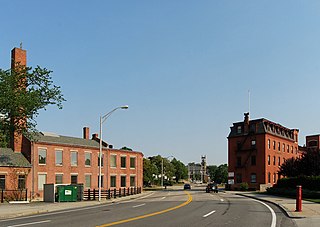
Moshassuck Square is an industrial historic district in Providence, Rhode Island, lining the banks of the Blackstone Canal just north of the Rhode Island State House. It consists of the few surviving buildings of the once-extensive American Screw Company complex, which was largely developed between the 1840s and 1870s, and was a major fixture in the Providence landscape prior to its destruction by fire in 1971. The buildings are in an area bounded by Charles Street on the west, Stevens and Hewes Streets on the north, North Main Street to the east, and Mill Street to the south. Prominent among them are the Stillman White Foundry and Fletcher Manufacturing Company office building, which stand on opposite sides of Mill Street near its crossing of the canal. At 127 Charles Street stands a three-story brick building built c. 1900 as a retail and residential building. The only surviving elements of the Screw Company complex are located at North Main and Hewes Streets, and now house the Providence Center.
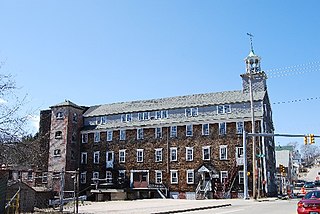
The Lippitt Mill is an historic mill at 825 Main Street in West Warwick, Rhode Island.
The city of Woonsocket in the U.S. state of Rhode Island was established as a union of six mill villages along the Blackstone River. These villages are described in more detail below.






















